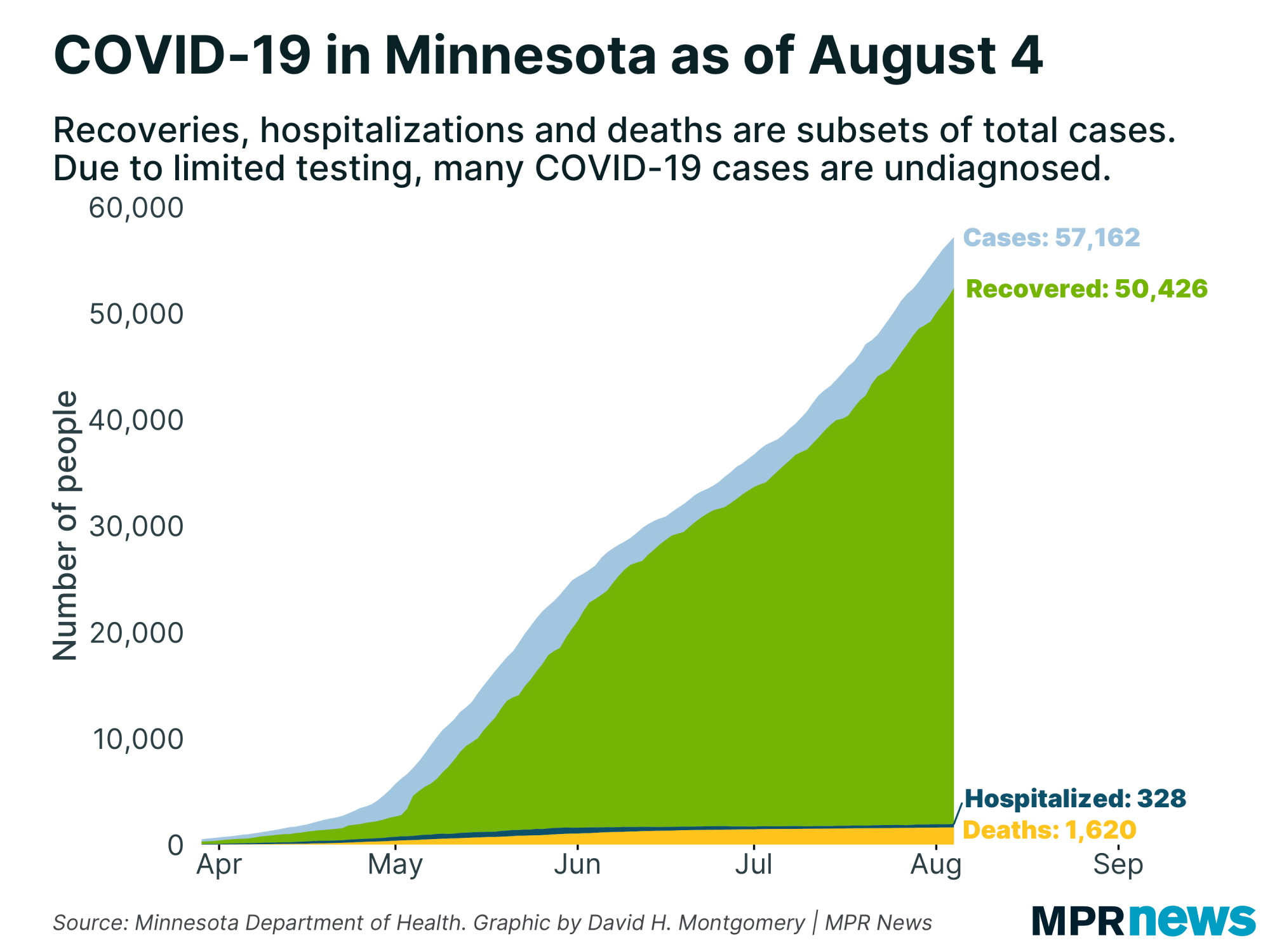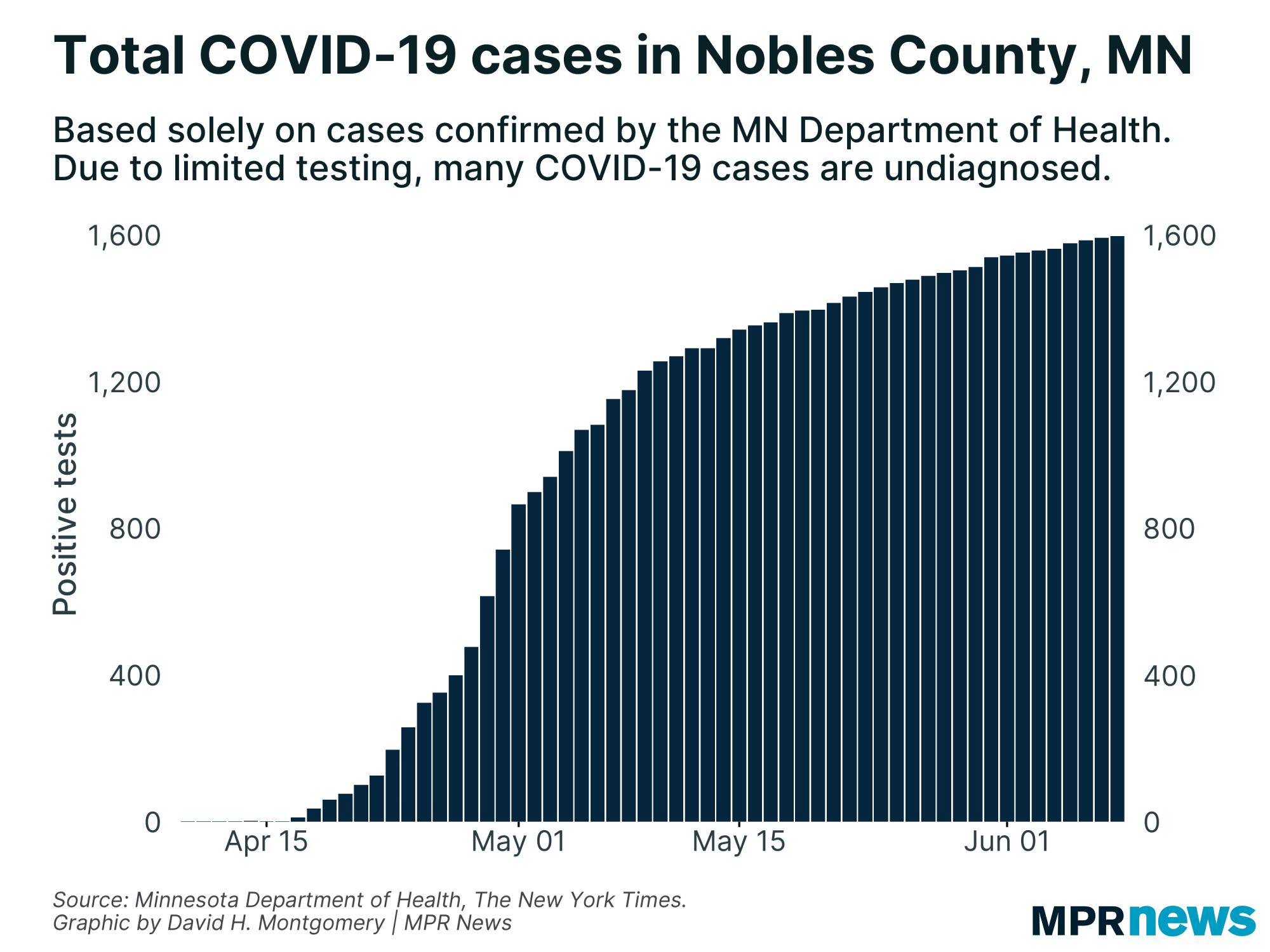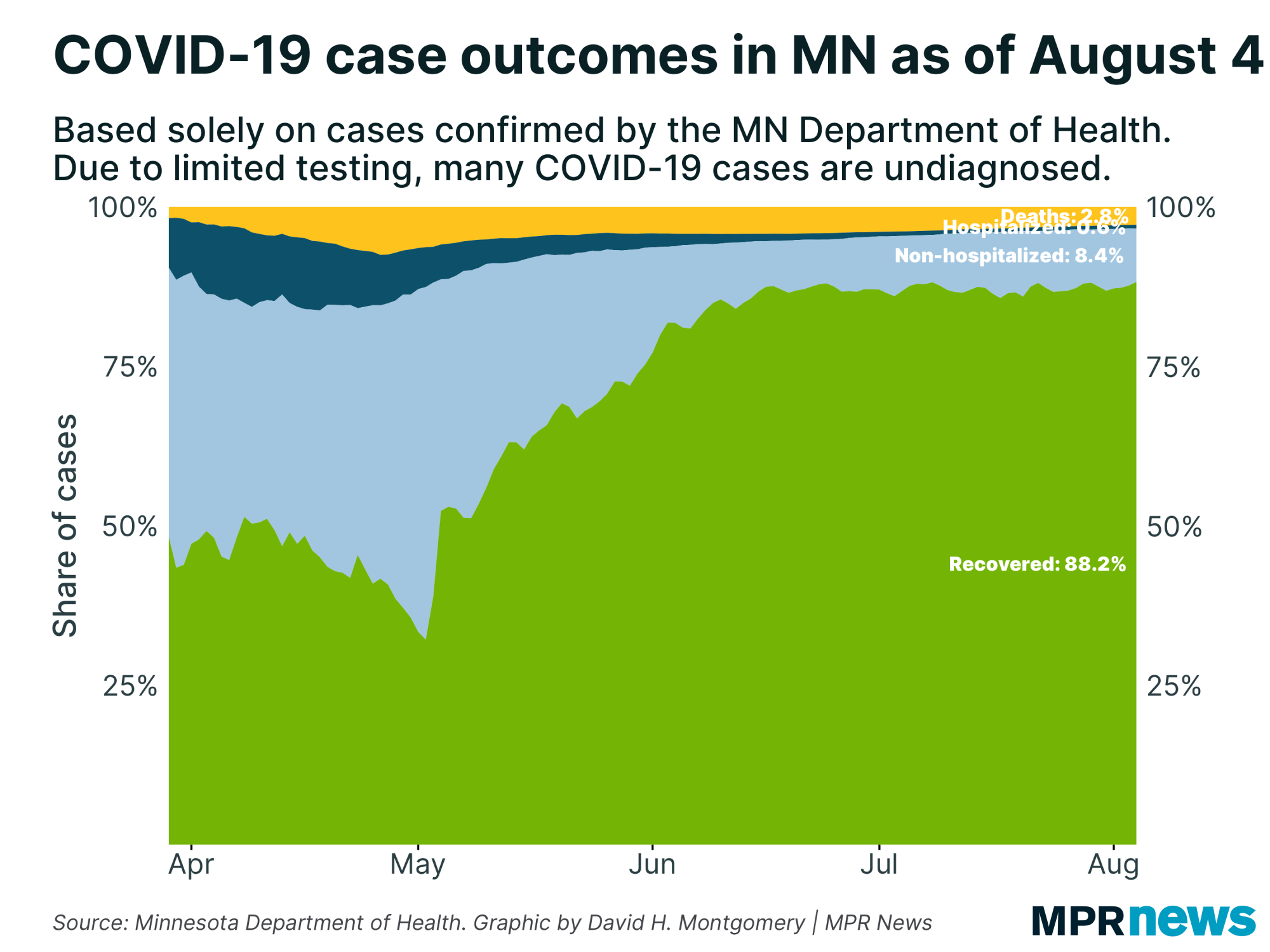May 6 update on COVID-19 in MN: 30 more deaths; total cases surge above 8K

Go Deeper.
Create an account or log in to save stories.
Like this?
Thanks for liking this story! We have added it to a list of your favorite stories.
Updated 6:46 p.m. | Posted: 5:30 a.m.
Minnesota’s COVID-19 toll climbed again Wednesday as the Health Department reported 485 deaths, up 30 from Tuesday as the total number of cases since the pandemic began surged to 8,579.
The numbers of people currently hospitalized (443) and in intensive care (180) remained relatively stable from the prior day.
The latest counts come a day after state budget and economic officials conceded that Minnesota’s economy won’t recover from the coronavirus anytime soon, and the state faces a $2.4 billion budget deficit lasting well into next year.

Budget forecasts showed big drops in consumer spending, sales taxes and wages. The state’s economic output is expected to drop three consecutive quarters before a return to positive territory, but it “does not get back to where it would have been without the pandemic,” state economist Laura Kalambokidis said Tuesday. “Some amount of economic activity is simply lost.”
Turn Up Your Support
MPR News helps you turn down the noise and build shared understanding. Turn up your support for this public resource and keep trusted journalism accessible to all.
Meatpacking at the center of case jumps
The escalation in positive cases continues to be driven by a handful of counties with outbreaks centered around meatpacking plants. Testing has intensified around those outbreaks and led to more positive tests for the disease.
Cases in Nobles County in southwestern Minnesota, where an outbreak centered around the JBS pork plant in Worthington, continue to swell. The county continued to have the largest outbreak outside the Twin Cities and the largest by far of any Minnesota county relative to its population.
About 1 in 20 people in Nobles County have tested positive for COVID-19. Cases there have jumped from a handful in mid-April to 1,082 on Wednesday as testing in the region accelerates and reveals more cases.
The JBS plant shut on April 20 as executives worked to control the disease’s spread. It partially reopened Wednesday with expanded hygiene and health monitoring measures.

Similar problems have been reported in Stearns County, where COVID-19 cases tied to two packing plants — Pilgrim’s Pride poultry plant in Cold Spring and Jennie-O Turkey in Melrose — have skyrocketed. An undisclosed number of workers at both plants have tested positive for the virus.
At the beginning of last week, there were 55 confirmed coronavirus cases in Stearns. By Sunday, as testing for the disease intensified, there were 589 and by Wednesday confirmed cases had jumped again to 975.
Kandiyohi County in west-central Minnesota is also seeing cases jump two weeks after officials with the Jennie-O turkey processing plant there said some employees had tested positive for the coronavirus. The county had confirmed three COVID-19 cases back then. On Wednesday, the Health Department reported 211 people have now tested positive.
As part of the effort to try and contain the spread, state officials and county officials have been working to add investigators who can contact those who’ve been confirmed with COVID-19 and trace their movements to alert others who might have been in contact with them.
Kris Ehresmann, the state’s infectious disease director, said 150 investigators were on the job last week and 160 were being added this week.
‘Tiny bit of breathing room’ on medical gear
Wednesday’s numbers showed total current hospitalizations rising to a record level, although the increase from Tuesday was small and the number of those patients needing intensive care ticked down a bit.
Controlling the spread of the disease so it doesn’t overwhelm the health care system was one of the Walz administration’s key goals as the pandemic hit. He’s argued that the stay-at-home orders and other measures to keep people out of crowded public spaces bought the system time to secure supplies and prepare for the surge.
Officials had some good news Wednesday on that front. The state appears to be doing better now securing the protective gear it needs for health care workers following an early, frustrating scramble for supplies at the start of the pandemic.
The market has stabilized somewhat and the state now had “a tiny bit of breathing room” to better consider the costs and risks of equipment purchases, Alice Roberts-Davis, commissioner of the Minnesota Department of Administration, told reporters. Hospitals also seem to be getting the supplies they need through normal channels, she added.
She cautioned, however, that acquiring N95 masks and gowns, gear crucial to health care worker safety, was was still a challenge and that the “burn rate” through those stockpiles will increase as Minnesota hospitalizations continue to rise toward peak.
Nearly all of those Minnesotans who’ve died from COVID-19 to date were living in long-term care facilities and had underlying health problems.
Asked on Wednesday why Minnesota’s death rate for the disease appears higher than other states, Ehresmann said the state’s intense focus on older people in congregate, long-term care settings led the state to confirm more cases and deaths in that vulnerable population, and that other states may be missing deaths tied COVID-19.
Some businesses back to work, others frustrated
The governor has said about 91 percent of Minnesota’s workforce is now able to return to their workplaces with hygiene and distancing rules in place, under his tweaked stay-at-home order. On Wednesday, he gave the OK to restart elective surgeries and dental services.
Walz fielded similar questions Tuesday amid news that some businesses and communities were chafing at the stay-at-home order, which has been running for more than a month.
The order kept people out of crowded public spaces, helping slow the outbreak and buying time for the state’s health care system to secure supplies and prepare for waves of cases and hospitalizations.
But, as Walz has acknowledged, it’s come at a steep economic cost for many who’ve been thrown out of work. Restaurants and bars remain the biggest sector still unable to bring customers back into their buildings.
Earlier this week a Twin Cities barbershop owner publicly defied Walz’s order and opened his shop to customers. Leaders in the town of Lakefield, in southwestern Minnesota, recently voted to support businesses that want to defy Walz’s order and reopen. In northwestern Minnesota, the Thief River Falls City Council asked for their city to be exempt from the order.
GOP leaders have also prodded Walz to move faster, even as COVID-19 cases continue to climb.
“I want things open as badly as they do,” the governor said, adding that reopening the wrong way could rekindle the disease’s spread and put the lives of vulnerable people at risk.
“This is one of those difficult things that, if we do this right, it'll appear like we're wrong because we didn't overrun the health care system,” he said. “It's a bit like someone who can't swim, and you keep them out of the water. Whether you can claim you kept them from drowning might have been a little debatable, but if they had jumped in the deep end, it would have been trouble."

Developments from around the state
Churches, small business owners sue Gov. Walz to end stay-home order
A group of small business owners and churches are plaintiffs in a lawsuit asking the U.S. District Court for Minnesota to strike down Gov. Tim Walz's stay-at-home order.
The churches are asking that they be allowed to hold in-person services. The businesses include a chain of hair salons, a gift shop and a minigolf course in Blaine. They're arguing that Walz's orders violate the Constitution and that they deserve compensation.
Attorney Doug Seaton said the plaintiffs feel like they've been unfairly asked to close while businesses like liquor stores remain open.
"They're very upset about it, so they've lost income in the case of the businesses, and they've lost the ability to conduct services on the part of the churches,” Seaton said. “These businesses and churches can all select the CDC guidelines but they've been selected as the victims of the governor's orders even though equally positioned other businesses and organizations are carrying on their activities.”
The governor's office says he was forced to take drastic action, but that it's well within his authority and similar to what other states are doing to protect citizens. State Attorney General Keith Ellison said in a statement Wednesday that his office hasn’t seen the lawsuit, but “I don’t need to see the specifics of the lawsuit to know that it’s a distraction from what we all need to be focused on — fighting the pandemic.”
“Let’s be clear that they’re choosing to play politics rather than focus on keeping people safe,” Ellison said.
— Jon Collins | MPR News
DNR to anglers: Stay close to home for Saturday’s fishing opener
The Minnesota Department of Natural Resources is urging anglers to stay close to home for this weekend's fishing opener. Officials are asking anglers not to stay overnight, to bring all the supplies they need, and to only travel as far as they can go and return on a single tank of gas.
Commissioner Sarah Strommen said the point is to protect rural communities.
“We know that that travel is one of the ways that the [corona]virus can spread that’s particularly true for some of our rural communities that may have more virus vulnerable populations,” Strommen said.
The DNR has already sold more than 350,000 fishing licenses this year. The department says it doesn't anticipate issuing citations and plans to continue to use an educational approach to enforcing the stay-at-home order.
Fishing resorts are open, although many are reporting large numbers of cancellations.
— Dan Kraker | MPR News
Thief River Falls calls on Walz to let it reopen completely
In northwestern Minnesota, the city of Thief River Falls says it wants an exception to the state’s stay at home order, to spare businesses more economic fallout from the COVID-19 outbreak.
The City Council and mayor all voted for a resolution Tuesday night asking the state to let the city reopen, despite a stay at home order that runs through May 18.
Mayor Brian Holmer says there aren’t any confirmed COVID-19 illnesses in the county now and that it isn’t fair businesses in towns like his are treated differently than businesses in nearby North Dakota.
“We’re not an overly huge community, and most of them would say that they’d be lucky to have three to five customers in the store at one time,” he said. “So there’s plenty of room for social distancing. And, if the big box stores can do it, they fell they can do it, too.”
— Tim Nelson | MPR News
MN Senate staffer tests positive for COVID-19
A Minnesota Senate staff member has tested positive for COVID-19, leading to the self-quarantine of senators and staff who might have been in contact with the person.
Senators and staff were alerted to the case within the past day and told that the Senate Republican caucus employee helped with contact tracing to determine who might have been in proximity to the infected person.
“All staff and senators who may have come in contact with this individual have been notified and have been advised to self quarantine,” one of two emails to Senate employees and members said. MPR News reviewed both emails.
It’s not clear how many staff members or lawmakers are being instructed to stay away from the Capitol and for how long. A Senate Republican spokesperson said she did not have that information Wednesday.
The disclosure comes as the Legislature moves into its busiest period with the May 18 adjournment bearing down. Many lawmakers and legislative aides have been working remotely since March as a precaution, but some have had to come to the Capitol to help develop and pass bills.
In March, a Minnesota House employee was presumed to have been infected and similar isolation steps were put in place.
The Capitol has been undergoing additional cleaning, lawmakers have been spread out during sessions and other social distance measures have been in place for several weeks.
— Brian Bakst | MPR News
Minnesota OKs using food aid to buy groceries online
People who get federal food assistance in Minnesota will be able to shop online for groceries as soon as next month.
The state’s Department of Human Services has a green light from the U.S. Department of Agriculture to make the benefits available for online ordering at local grocery stores.
Assistant Commissioner Nikki Farago said recipients of Supplemental Nutrition Assistance Program (SNAP) benefits can already use Walmart or Amazon in other states under federal rules, but the expansion will make it available in Minnesota and at many other stores.
Farago said her agency is working with stores and its electronic benefit transfer card provider to make changes to the system, likely to go into effect in June.
About 378,000 low-income people in Minnesota get SNAP benefits, about 40 percent of them children.
— Tim Nelson | MPR News
Correction (May 6, 2020): A previous version of this brief misstated availability of online shopping at Amazon and Walmart in Minnesota. The above copy has been corrected and updated.
Top headlines
Pork processing resumes at JBS plant shut down by pandemic: The move comes a week after an executive order from President Trump designed to get the country’s meat supply chain back up and running.
Minnesota resorts worry about their survival: Many vacationers are canceling resort reservations because of the coronavirus pandemic. Some resorts have chosen not to open at all. Those that do are having to reimagine the summer experience in the era of social distancing.
Pandemic brings fewer drivers, more speeding to Minnesota highways: The rush in speeding shows up in multiple ways in an MPR News analysis of speeding tickets issued by the Minnesota State Patrol, which enforces traffic laws on Minnesota highways.
Competing against 'essential' big boxes, small retailers cry foul: Businesses that long to invite customers inside say they are operating at an unfair disadvantage. State officials agree.
Facing unprecedented COVID-19 restrictions, Minnesota chaplains still comforting others: Chaplains in hospitals and in the community offer spiritual solace and sometimes help connect families to loved ones separated to limit coronavirus spread.
MN hospitals welcome return of elective procedures; nurses union wary of move: In an executive order Tuesday, Gov. Tim Walz lifted the temporary ban that he imposed seven weeks ago, which was part of an effort to save scarce masks and gowns for the COVID-19 fight.
COVID-19 brings red ink back to state budget: A new budget update projects Minnesota will have a $2.4 billion deficit through July 2021. That’s a huge swing from the surplus predicted back in February.
COVID-19 in Minnesota
Health officials for weeks have been increasingly raising the alarm over the spread of the novel coronavirus in the United States. The disease is transmitted through respiratory droplets, coughs and sneezes, similar to the way the flu can spread.
Government and medical leaders are urging people to wash their hands frequently and well, refrain from touching their faces, cover their coughs, disinfect surfaces and avoid large crowds, all in an effort to curb the virus’ rapid spread.
The state of Minnesota has temporarily closed schools, while administrators work to determine next steps, and is requiring a temporary closure of all in-person dining at restaurants, bars and coffee shops, as well as theaters, gyms, yoga studios and other spaces in which people congregate in close proximity.


